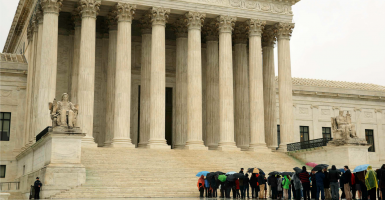In the next three weeks, the U.S. Supreme Court will be wrapping up its 2014-2015 term. By the end of this month, the Court will hand down opinions in the most anticipated cases of the year. Here are seven cases to watch for in the coming weeks:
- Reed v. Town of Gilbert: The Town of Gilbert, Ariz., regulates when, where and how many signs may be displayed around town. The Good News Community Church used signs to invite people to its services. Because its signs fall under the “qualifying event” category, the church was only permitted to put up six square feet signs a mere 12 hours before their Sunday morning services (late Saturday night when they are hard to see). By comparison, real estate signs may be 80 square feet and on display for 30 days; and political signs may be 32 square feet and on display for four and a half months before an election. The church challenged the town’s sign code as an impermissible content-based restriction on speech in violation of the First Amendment. The Supreme Court will decide whether the town’s claim that the ordinance lacks a discriminatory motive is enough to justify its differential treatment of religious signs.
- Texas Department of Housing and Community Affairs v. The Inclusive Communities Project: This case involves claims that Texas’ housing agency violated the federal Fair Housing Act, which prohibits making housing unavailable to an individual “because of” or “based on” race. The Inclusive Communities Project alleges that the Texas agency disproportionately approved low-income housing tax credits to developers in minority neighborhoods while disapproving tax credits in “predominantly Caucasian neighborhoods,” leading to a concentration of low-income housing and effectively creating segregated housing patterns. Though the Inclusive Communities Project was unable to prove any intentional discrimination by Texas authorities in their administration of this program, the lower court sided with the group based on the disparate impact theory—that the actions taken by Texas had a statistically disproportionate impact on minorities, even if there was never a discriminatory motive. This is the third case to reach the Supreme Court involving disparate impact claims under the Fair Housing Act, but the last two settled before the Court could rule.
- King v. Burwell: What is the meaning of the four words “established by the state,” found in Section 36B of the Internal Revenue Code? The future of Obamacare rests on these four words, as the justices consider whether the law limits tax credits to state-run exchanges or whether tax credits also may be extended to the federally run exchanges. One of the architects of Obamacare, Jonathan Gruber, has said this difference was deliberately inserted into the statute to give state governments an incentive for establishing their own exchanges. This proved to be a political miscalculation because a majority of the states opted not to set up exchanges. A ruling for the challengers will deliver a significant blow to Obamacare—affecting not just the exchanges, but also the employer and individual mandates.
- Walker v. Texas Division, Sons of Confederate Veterans: In general, the government may not discriminate against certain viewpoints by preferring some speech over others when those viewpoints are expressed by private individuals. But when the government itself is speaking, it may choose to endorse certain views and speak certain messages. If the government issues pamphlets that say “Fight Terrorism,” it certainly is not required to offer pamphlets endorsing terrorism as well. But what about license plates? Are messages on specialty plates government speech or private speech? The state of Texas issues a standard license plate but authorizes some specialty plates for an additional fee. The Sons of Confederate Veterans sought permission to create a specialty license plate featuring the group’s logo and the Confederate flag. Texas denied the group’s request after receiving hundreds of public comments opposing their proposed license plate. At issue before the Supreme Court is whose speech is reflected on license plates—the government’s or the individual’s?
- Utility Air Regulatory Group v. EPA: Congress authorizes the Environmental Protection Agency to regulate public health risks from hazardous air pollutants emitted by electric utilities when “appropriate and necessary.” Following this mandate, the EPA adopted a rule regulating these emissions that costs $9.6 billion per year (according to EPA’s own estimates), while only generating $3-6 million per year in societal benefits. As the Utility Air Regulatory Group explains, that’s a “$1 ‘benefit’ for every $1,500 spent.” The group sued the EPA claiming that the agency may not ignore costs when determining the “appropriateness” of regulations. Although the lower court sided with the EPA, reasoning that “appropriateness” is “open-ended” and “ambiguous,” a dissenting judge pointed out that cost consideration is “a central component of ordinary regulatory analysis.” Now, the Supreme Court will weigh in on the EPA’s costly rule.
- Horne v. Department of Agriculture: Under a New Deal era marketing order intended to maintain profits for domestic raisin producers, farmers are required to sell their raisin crops to raisin handlers, who then remove a portion of the crop from the market for the federal government to destroy or sell overseas at bargain barrel prices. The government sets the compensation price that the producers are to be paid for the surrendered raisins. For 2002-2003, the government set the compensation price for raisins below the cost of production and required the farmers to hand over 47 percent of their crop; in 2003-2004, the government set the price at zero dollars for 30 percent of their crop. At that point, California raisin farmers Marvin and Laura Horne challenged this scheme as a violation of the Fifth Amendment’s Takings Clause, which requires that the government pay “just compensation” when it “physically takes possession of an interest in property.” The lower court ruled against the Hornes, holding that the takings rule applies only to real property, such as the Hornes’ farm, but not personal property, like their raisins. Now the Supreme Court will decide whether government’s raisin scheme violates the Constitution.
- Obergefell v. Hodges: Does the 14th Amendment require states to license same-sex marriages? Must states recognize same-sex marriages lawfully performed in another state? This may be the most anticipated decision of the term. Since the Supreme Court’s 2012 decision in United States v. Windsor, striking down the federal definition of marriage in the Defense of Marriage Act, traditional state marriage laws and constitutional amendments have been struck by judges in many states across the country. Same-sex couples from Kentucky, Michigan, Ohio and Tennessee challenged their states’ marriage and non-recognition laws. The lower court ruled in favor of the states, finding that the issue should be left to the customary political process. The Court will decide whether states may choose their marriage policy or be required to accept a national definition of marriage.





























